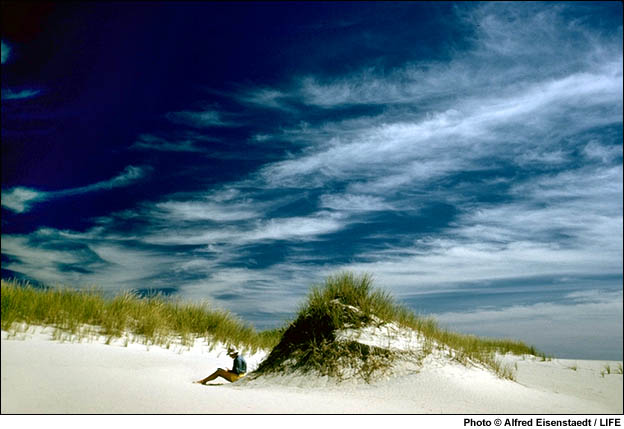|
|
|
|
Back |
 |
Next |
|
|
||
|
Another Vineyard personage I photographed with Eisie was William Styron. Because of my history with Bill Styron (Styron was a guest on my TV show The Vineyard Voice and featured in my magazine), Eisie asked me to arrange the shoot. The photograph Eisie ended up using in his Vineyard book was of Bill Styron sitting alone in his yard reading a newspaper. In the background is Styron's private dock surrounded by distantly moored boats. Besides photographing Eisie photographing Styron, I also took some shots of Rose Styron when she joined us during the session. Perhaps it is this kind of sharing, for better or worse, that has made photography the force it has become. And it is this force that defined Eisie’s life for over 70 years. Eisie was always proud to let you know that he was a successful photographer in Germany long before leaving his homeland for the United States. In the early 1930s, Germany was publishing more magazines than any country in the world, and Eisie’s new genre of candid photographs were in great demand. Having gained recognition in Europe for his journalistic-style photographs, Eisie was honored as one of the few photographers allowed in to photograph the first meeting of Hitler and Mussolini in 1933. Shortly after, as Hitler’s rise to power shut down many of Germany’s magazines, Eisie fled from Germany in 1935 with his widowed mother. “It was one of the best decisions I made in my life,” Eisie once told me with a big grin as he let out a childish laugh. When it came to sharing his photographs with Vineyard friends, Eisie was most generous. He loved taking photographs of island people he found interesting. On many occasions, Eisie would mail signed prints to the people he photographed. It always excited him to receive a glowing thank you note or telephone call. On the flip side, as amazing as it may sound, there were some people who lacked the wherewithal to take a little time and let Eisie know that they received his pictures. This bothered Eisie greatly. Sometimes he would telephone and ask if they received the photographs. A weak apology and perhaps feigned embarrassment would result. Such people never received another Eisenstaedt picture. And, even though Eisie often amusingly referred to himself as a “mouse” (he was 5’3” with shoes on), his memory was of elephantine proportion. I bore witness to Eisie’s world recognition and legendary memory while in Los Angeles in the early 1990s. Eisie was doing a show for Circle Galleries in LA, and I met up with Eisie and Lulu a day after the opening. I was in LA sharing time with an old college friend, Michael King, who was the owner of King World. Michael invited us to a private party he was sponsoring for the first elected woman President of the Republic of Ireland, Mary Robinson. While at the party, a curious thing happened. In attendance were many high-profile actors and actresses; as the evening wore on, the President’s husband (an avid photographer) found out that Eisenstaedt was present. Almost in disbelief, the party came close to to a halt as the President and her husband came over to greet Eisie. Then, much to my amazement and I am sure that of others, Ireland’s first family posed for numerous pictures with Eisie. The president’s husband even took a few snaps with a camera that one of his aides was carrying. What was curious about this scene, was the fact that Ireland’s first family was obviously not familiar with the names of many of Hollywood’s attending elite. However, they were very familiar with the name of the internationally famous Alfred Eisenstaedt, and were flattered to meet and be photographed with him. The next day, I took Eisie and Lulu to
Hugh Hefner’s Playboy Mansion for lunch. I had previously met Hefner’s
right hand man, Dick Rosensweig, when he and his wife were vacationing
on the Vineyard. Before eating, Dick gave us a tour of the Mansion’s grounds
with its famous pink flamingos and aviary. Afterwards, we were seated at
the dining room table and served drinks and hors d’oeuvres by a white-gloved
attendant. Eventually, Hugh Hefner made his monogrammed black silk pajama
appearance at the head of the table. After talking about his new family
life; the novelty of having children and their playthings in the Mansion;
and other personal and Playboy-related conversation, Eisie suddenly brought
up the subject of some negatives he wanted back from Hefner. It was obvious
that Hefner was taken aback by Eisie’s request. “What negatives would that
be?” asked Hefner. “Don’t you remember,” said Eisie, “I photographed you
and your daughter Christy over thirty years ago on (I forget the exact
date Eisie gave). You asked me for the negatives so you could make copies.
You never returned them to me!” Looking embarrassed, Hefner turned to his
attendant and said, “Could you make a note and have someone look for Mr.
Eisenstaedt’s negatives.” Then, turning to Eisie he said, “I am sorry,
I’ll make sure the negatives are returned to you if we find them.” As we
drove away after lunch, Eisie said, “He’ll never send me the negatives,
he was just saying that to be polite.”
|
|
|
| The
Vineyard 1 |
2 | 3
| 4 | 5
| 6 | 7
| 8
9 | 10 | 11 | 12 | 13 | 14 | 15 | 16 | 17 View the Index Page See - The Icons - The Portraits - Photos of Eisie |
| Contents | Editorial | The Platypus | Links | Copyright |
| Past Features | Camera Corner | War Stories | Dirck's Gallery | Comments |
| Issue Archives | Columns | Forums | Mailing List |